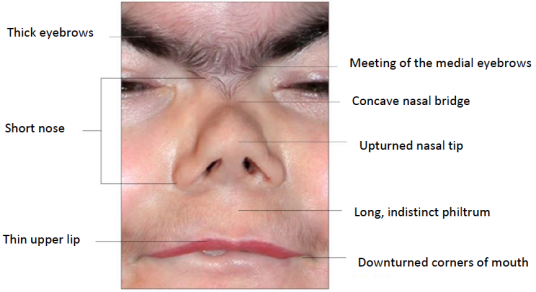» What is Cornelia de Lange Syndrome

What are the Physical Characteristics of Cornelia de Lange Syndrome?
There are a combination of signs and symptoms that define the CdLS spectrum phenotype. Experts from the International CdLS Consensus Group (see Table 1 on page 5 for voting process) have classified these into cardinal features (considered to be most common in CdLS) and suggestive features (which are less specific to CdLS) (Recommendation 1 = R1). When assessing characteristics, cardinal features are assigned 2 points each if present, and suggestive features are given 1 point each if present (R2; See Box 1, page 5).
|
Box 1 | Clinical features of Cornelia de Lange Syndrome
Meeting of the medial eyebrows in the midline and/or thick eyebrows
Global developmental delay and/or intellectual disability/learning disability
11 points and above, of which at least 3 are cardinal: classic CdLS |
It is important to remember that an individual with CdLS may not have all of these characteristics. An individual with CdLS may have many of these characteristics or only a few.
CdLS Spectrum Clinical Criteria (scoring)
The International CdLS Consensus Group has agreed on criteria for the CdLS spectrum which is based on the cardinal and suggestive features (as shown in Box 1, page 5). These criteria are based on points.
- A score of 11 or more indicates classic CdLS if at least 3 cardinal features are present.
If a score of 11 or more is reached the diagnosis of CdLS is confirmed, regardless of whether there is a change in one of the 7 known genes for CdLS.
- A score of 9 or 10 indicates non-classic CdLS, if at least 2 cardinal features are present.
- A score of 4 or more is sufficient to warrant genetic testing for CdLS if there is at least 1 cardinal feature present.
- A score of 4 or less is insufficient to warrant genetic testing.
|
Fig. 3 | Cardinal facial features of Cornelia de Lange syndrome. Facial features that are the most characteristic for Cornelia de Lange Syndrome (CdLS) include the meeting of the medial eyebrows in the midline, thick eyebrows, a short nose, concave nasal ridge and upturned nasal tip, a long and smooth philtrum, a thin upper lip and downturned corners of the mouth. Non-facial features (not shown) that are considered to be cardinal features of CdLS include the absence of one or more fingers, the absence of all fingers and/or toes and hernias in the diaphragm. |
Severity scoring procedures have been described to indicate the severity of CdLS (2, 10-12). It should be noted that none of these procedures consider the severity of CdLS as experienced by families. Scoring procedures also do not estimate the severity of all organ systems that may be affected in CdLS.
The International CdLS Consensus Group suggests current severity scoring schemes should be used cautiously. The group acknowledges the need for the development of a severity score that represents severity as experienced by families (R3).
<previous page | next page>